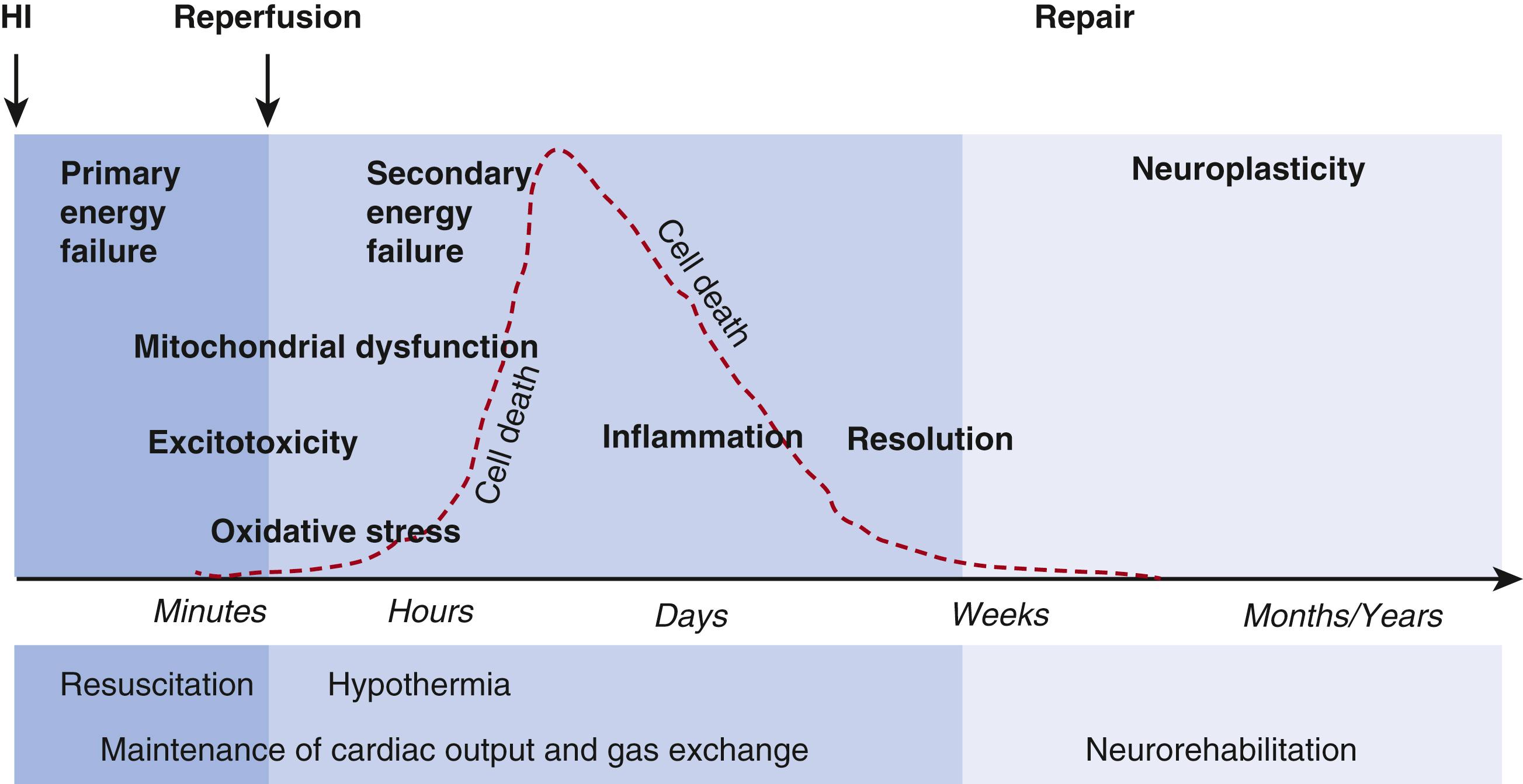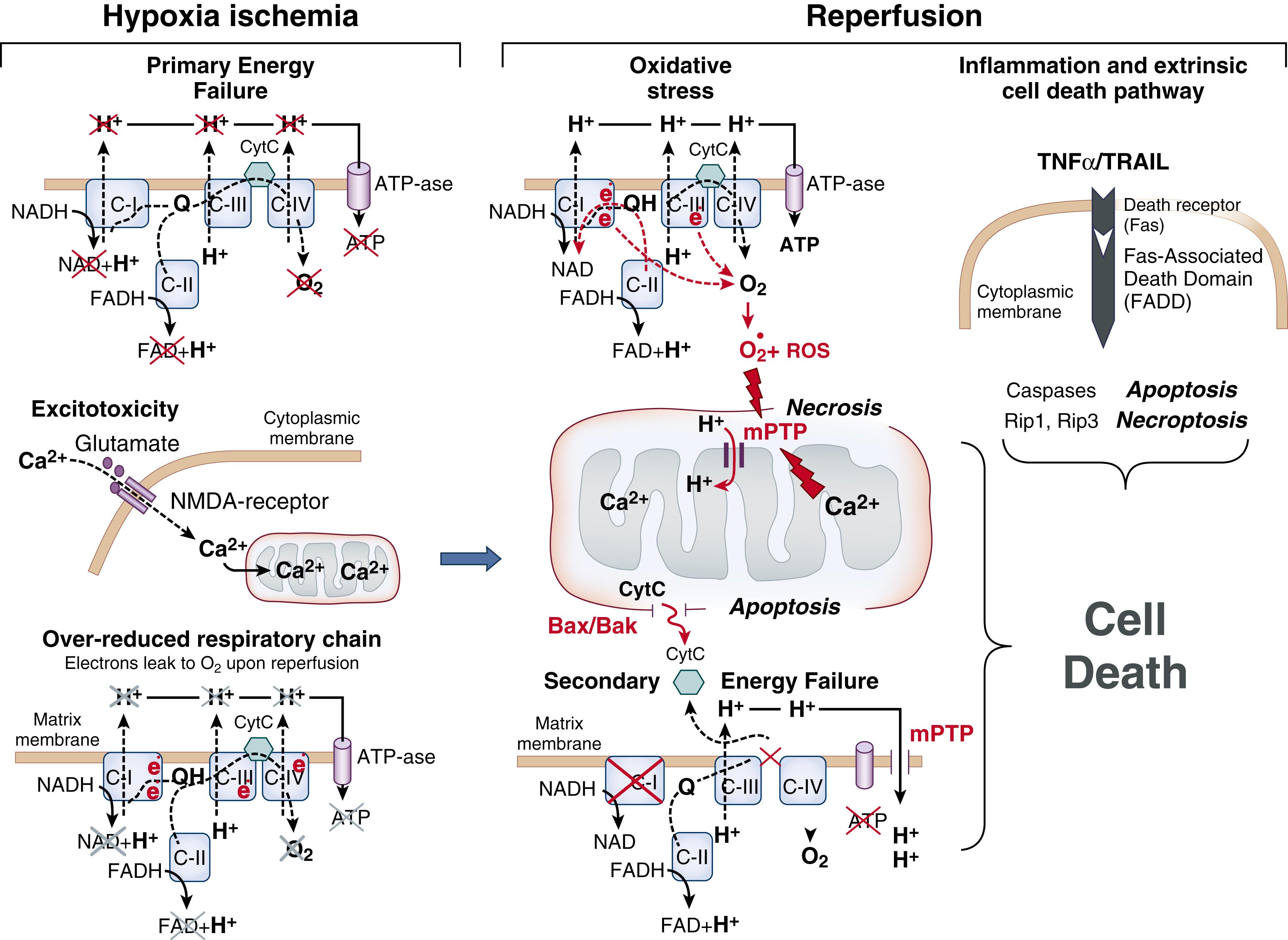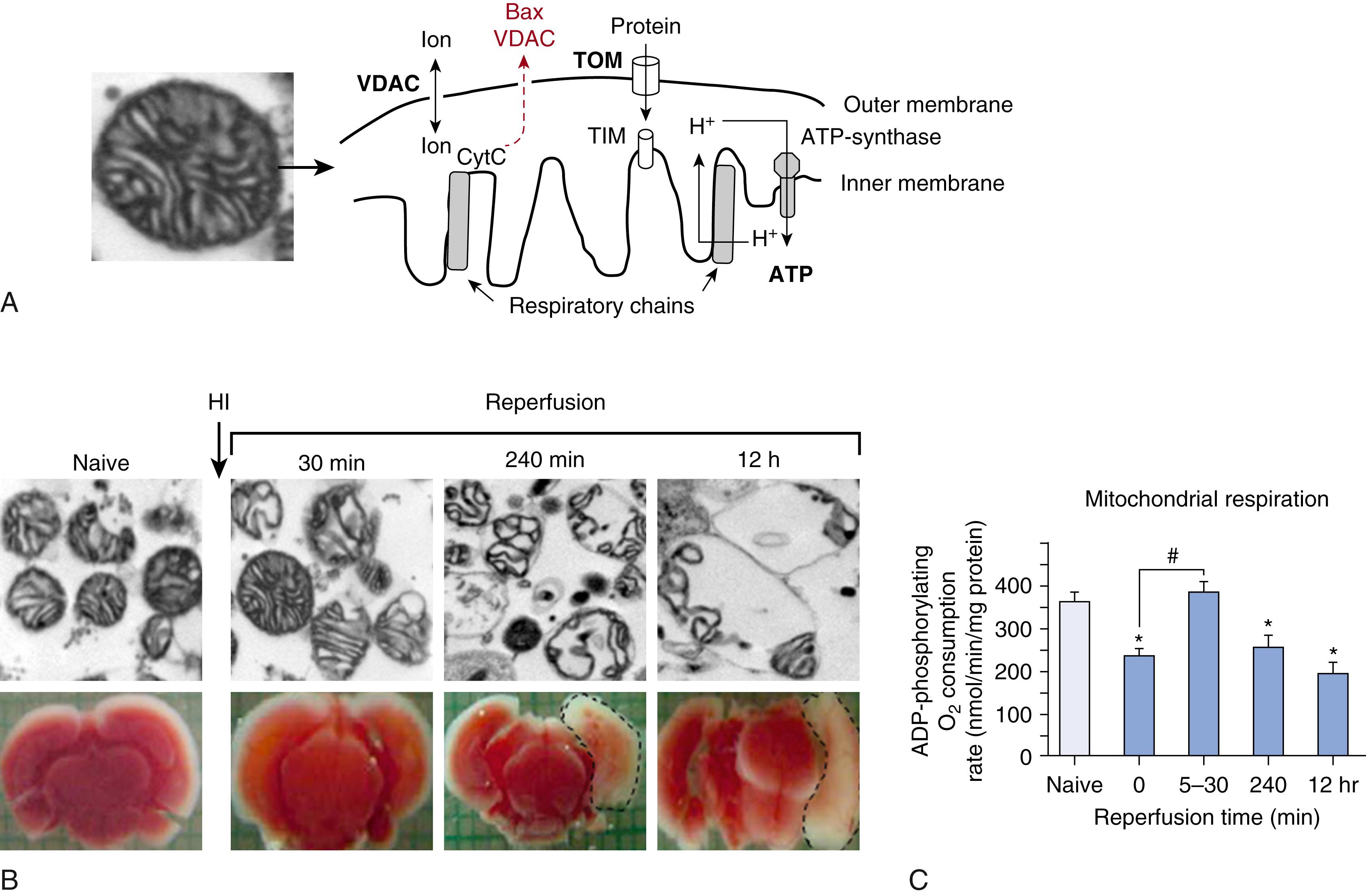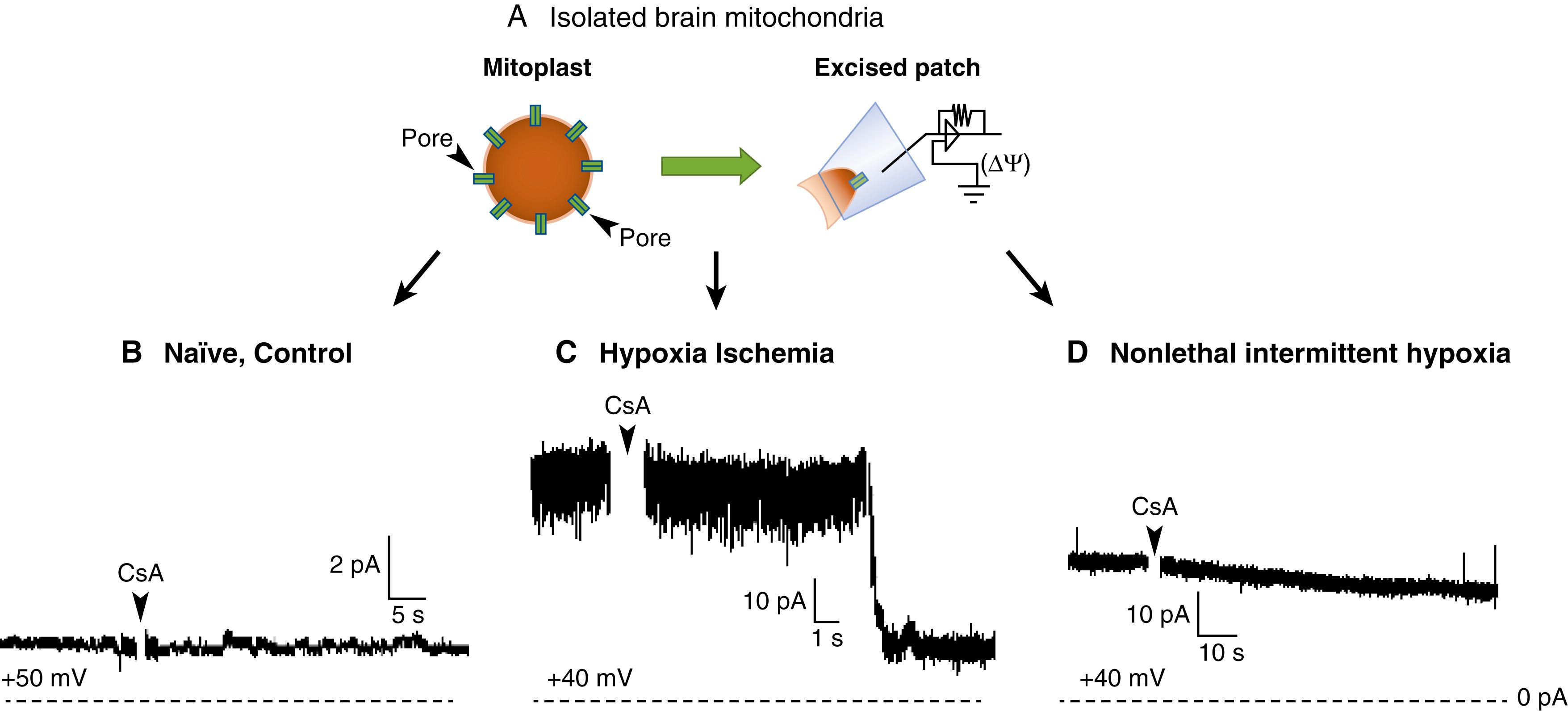Physical Address
304 North Cardinal St.
Dorchester Center, MA 02124
This work was partially supported by NIH grants NS 100850, NS 099109, NS 088197.
The pathophysiology of neonatal hypoxic-ischemic (HI) brain injury or hypoxic-ischemic encephalopathy (HIE) defines the response of central nervous system (CNS) to ischemia and reperfusion. Neonatal HI brain injury usually occurs due to a collapse of systemic circulation at or near birth or during the neonatal period. If not interrupted, HI insult can be lethal. If the systemic circulation is restored in timely fashion, then full or partial recovery of the brain and other organs is expected. The extent of this recovery will determine the absence or presence, as well as the severity of HIE. Thus the return of the systemic and cerebral circulation (reperfusion) defines the disease state following HI insult. Because the brain is extremely sensitive to ischemic injury, neurologic outcome following neonatal HI remains a major clinical concern. What determines the risk for HIE?
Analysis of neonatal outcomes of cesarean deliveries associated with maternal cardiovascular crisis revealed that, when delivered within 5 minutes of maternal circulatory arrest, 70% of infants were free of neurologic sequelae. However, if the delivery was delayed by 6 to 10 minutes, only 13% of infants developed normally. Models of neonatal asphyxia and cerebral ischemia-reperfusion demonstrated that the length of ischemia is the most critical determinant of severity of injury. The quality of reperfusion also has significant impact on the extent of cerebral damage. Even brief ischemic insults followed by suboptimal oxygen redelivery upon reperfusion may cause surprisingly extensive cerebral tissue loss. On the other hand, when the length of neonatal ischemic event extends over 5 to 7 minutes at physiologic temperature, , reperfusion contributes to both cellular recovery and injury via mechanisms driven by reintroduction of oxygen and energy substrates (e.g., oxidative stress and apoptosis). Thus, two interconnected biologic processes, ischemia and reperfusion, serve as pathologic ground for evolution of HIE. A pathophysiologic essence of ischemia is primary energy failure driven by acute oxygen and substrate deprivation. The pathophysiology of reperfusion is more complex, as reperfusion initiates both cellular recovery and may be detrimental to cellular recovery mechanisms ( Fig. 167.1 ).

Primary energy failure is characterized by acute depletion of high-energy phosphates, adenosine triphosphate (ATP) and phosphocreatine (PCr) in the brain. Absence of the oxygen results in cessation of electron transport in the mitochondrial respiratory chain ( Fig. 167.2 ). Therefore, mitochondrial complexes cannot pump out protons from the matrix space into intermembrane space and maintain a proton gradient (proton motive force) across the inner mitochondrial membrane. Without this proton motive force, phosphorylation of adenosine-diphosphate (ADP) to ATP by ATP-synthase is impossible. This defines an energy failure state. Once circulation is failed, a bioenergetic crisis develops very quickly; significant depletion of PCr, ATP, and elevation of ADP and adenosine monophosphate (AMP) occurs in 10 seconds and profound depletion of energy charges ensures within 5 to 7 minutes of an acute ischemic insult. For a short time, hydrolysis of residual ATP stores and the use of PCr for phosphorylation of ADP partially supports cellular energy demand. Meanwhile, anaerobic glycolysis becomes the main mechanism of energy production. In neonates, cerebral immaturity is associated with poorer efficiency of glycolysis compared to the mature brain. Neonatal rats subjected to HI demonstrated limited activation of anaerobic glycolysis in their brains due to developmental deficiency of the glucose transporter proteins. This suggests that in the developing brain, the acuity of primary energy failure may be greater compared to the mature CNS. The immediate sequelae of primary bioenergetic crisis is a failure of cellular structure and function-maintaining ion pumps, such as Na-K + ATPase, leading to a loss of ion gradient across cellular membrane, depolarization, and cytotoxic swelling. Experimental and clinical research offers clear evidence for a strong association between the severity of primary bioenergetic crisis and poor neurologic prognosis following neonatal asphyxia. In addition to primary energy failure, other fundamental biochemical responses to ischemia extend their contribution to injury into the reperfusion stage of the disease.

Acute oxygen deprivation results in a complete reduction of the electron-transferring components; flavins; iron-sulfur clusters; coenzyme Q; and cytochromes a , b , and c , in the mitochondrial respiratory chain (see Fig. 167.2 ). Primary Krebs cycle electron donors (NADH and FADH 2 ) are also fully reduced. Ischemic over-reduction of NAD + to NADH contributes to inhibition of glycolytic ATP generation, as oxidation of glyceraldehyde 3-phosphate requires NAD + . Next, upon reperfusion-driven reintroduction of oxygen, in special circumstances, fully reduced redox centers (electron carriers), like flavins and quinones, may leak electrons onto oxygen, producing superoxide. Thus over-reduction of electron carriers during ischemia predisposes the respiratory chain to excessive electron leak and formation of oxidative radicals during reperfusion (see Fig. 167.2 ).
Anaerobic glycolysis produces not only ATP but also lactate, as the ischemia inhibits pyruvate dehydrogenase complex and inhibits the respiratory chain. As a result, pyruvate cannot be utilized in the Krebs cycle and is shunted into lactic acid. Even in the absence of any substrate delivery, the preischemic glucose and glycogen levels are sufficient to increase tissue lactate from 1.5 to 12 to 14 μmole/g within 2 to 3 minutes. In isolated brain mitochondria, lactic acidosis inhibits the respiratory chain, contributing to ischemic bioenergetic collapse. In developing and mature brains, ischemia also results in a dramatic (approximately 30-fold) accumulation of succinate, while the levels of other Krebs cycle intermediates are depleted. These metabolic changes has been proposed as mechanistic factors predisposing to oxidative stress upon reperfusion. ,
On a cellular level, ischemia causes over-excitation of neurons and oligodendrocytes, the event driven by excessive release of neurotransmitters (glutamate) and bioenergetic failure of glutamate reuptake. Glutamate release and activation of the glutamate receptors, N -methyl- D -aspartate (NMDA) and AMPA, α-amino-3-hydroxy-5-methyl-4-isoxazolepropionic acid, initiates an excitotoxic cascade where downstream cellular Ca 2+ influx plays a central role in cellular damage during reperfusion. Thus in addition to primary energy failure, ischemia sets in motion biochemical changes that limit cellular bioenergetic restoration and cellular recovery upon reperfusion.
The concept of secondary energy failure rests on experimental and clinical data demonstrating brisk, near-full or partial restoration of high-energy phosphates in the ischemic brain upon reperfusion. , These data imply that upon oxygen and substrates redelivery, postischemic mitochondria are capable of ATP generation. However, following few hours of reperfusion, 6 to 8 hours in human neonates, cerebral bioenergetics progressively decline, evidenced by secondary depletion of high-energy charges in the postischemic brain. The mechanism of secondary energy failure closely relates to changes in mitochondrial capacity to generate ATP during reperfusion. In the Rice-Vannucci model of neonatal HI-brain injury (ligation of the common carotid artery and exposure to hypoxia), cerebral mitochondria, isolated immediately after the insult, exhibited significantly decreased respiratory control ratio (a measure of mitochondrial coupling) mostly due to inhibited phosphorylating respiration. , At 3 hours postreperfusion, the mitochondrial phosphorylating respiration and respiratory control ratio had partially recovered. In the same mouse model, when tested at 30 minutes of reperfusion, post-HI mitochondria exhibited near-full restoration of their ADP-phosphorylating capacity. In mature gerbils, after 30 minutes of global brain ischemia, at 5 to 30 minutes of reperfusion, mitochondrial respiration fully regained their capacity to phosphorylate ADP, which was significantly depressed immediately after ischemic insult. However, at 120 minutes of reperfusion there was a secondary decline in mitochondrial phosphorylating activity. These reperfusion-associated changes in mitochondrial respiration were paralleled by similar changes in enzymatic activities of respiratory chain complexes I to III, but not complex IV. , Regardless of the extent of mitochondrial functional recovery, these and other studies have shown reproducible restoration of oxidative phosphorylation after HI followed by a progressive decline of mitochondrial function after few hours of reperfusion (i.e., secondary energy failure).
To understand a pathogenic significance of secondary energy failure, we need to determine whether secondary bioenergetics crisis contributes to the evolution of cellular injury or simply reflects metabolic shutdown in the dying tissue. Vannucci and colleagues examined temporal changes in the brain high-energy phosphates reserves and markers of neuronal damage during post-HI reperfusion. Based on the close association of PCr levels with the loss of neuronal protein markers and cerebral injury scores at 6 to 18 and at 24 to 48 hours of reperfusion, the authors proposed that secondary energy failure represents the consequence, rather than the cause of ultimate cellular death. Others also reported a temporal association between neuronal protein (microtubule-associated protein 2 [MAP2]) loss, caspase 3 activation, and secondary mitochondrial dysfunction. Importantly, caspase 3 activation was detected at the time-point of reperfusion, when mitochondria exhibited near-normal respiratory activity, suggesting that activation of this cell death pathway precedes secondary mitochondrial dysfunction. To link the evolution of HI brain injury to cellular bioenergetics, the mitochondrial morphologic and functional changes in the brains that ultimately developed infarcts were analyzed. Immediately after the HI-insult, mice exhibited no injury and electron microscopy of mitochondria isolated from the same postischemic hemisphere demonstrated no readily detectable morphologic changes compared to controls ( Fig. 167.3B ). However, mitochondrial phosphorylating respiration was significantly depressed compared to control organelles (see Fig. 167.3C ). At 30 minutes of reperfusion, in the absence of detectable damage, mitochondria isolated from ischemic hemisphere exhibited near-full recovery of ADP-phosphorylating respiration (see Fig. 167.3C ). Electron microscopy, however, revealed pathologic swelling of some organelles. At 4 hours of reperfusion, tri-phenyl-tetrazolium chloride staining detected an evolving brain infarct (see Fig. 167.3B ). This was coupled with secondary depression of mitochondrial respiration (see Fig. 167.3C ) and a loss of mitochondrial matrix integrity and swelling. At 12 hours, there was a clearly identified infarct, severely depressed mitochondrial respiration, and extensive organelle disintegration (see Fig. 167.3B and C). Close temporal relationships between mitochondrial swelling, the secondary decline in mitochondrial phosphorylating respiration, and evolution of the infarct suggests that secondary mitochondrial dysfunction may contribute to the reperfusion brain injury following HI insult. Of note, neuroprotective action post-HI hypothermia has been linked to a decreased cellular energy demand in asphyxiated neonates. To clarify the role of secondary energy failure in HI brain injury we need better understanding the mechanisms of secondary mitochondrial dysfunction.

Mitochondrial matrix content is isolated from cytosol by two membranes, the ion-impermeable inner membrane and outer mitochondrial membrane, which is ion-permeable via voltage-dependent anion-selective channel (VDAC) (see Fig. 167.3A ). The import of nuclear-coded proteins for mitochondria is assisted by the translocase of the outer membrane (TOM) and by the translocase of the inner membrane (TIM). These translocases control movement of proteins through the mitochondrial membranes. Impermeability of the inner mitochondrial membrane for ions/protons supports the proton motive force for ATP-synthase activity and mitochondrial membrane potential (ψm). The ion/proton leakage of the inner mitochondrial membrane may occur due to action of ionophores (e.g., free fatty acids) or due to an opening of ion/proton permeable channel/pore, which allows H + protons backflow into matrix, bypassing ATP-synthase. Therefore, activation of mitochondrial permeability transition pore (mPTP) renders mitochondria incapable of ATP production due to proton leak known as the state of uncoupled mitochondrial respiration . Thus if during reperfusion, brain mitochondria activate mPTP, then uncoupling of mitochondrial respiration explains secondary mitochondrial dysfunction (see Fig. 167.2 ). Why does the matrix membrane leak?
In the brain, HI-insults results in excessive release of glutamate, activation of NMDA, and AMPA glutamate receptors (see Fig. 167.2 ). The primary detrimental mechanism, downstream to glutamate-NMDA and AMPA interaction, is excessive intracellular Ca 2+ flux. , Mitochondria are the organelles that actively regulate Ca 2+ level in the cytosol by quickly taking Ca 2+ up into their matrix via a mitochondrial Ca 2+ uniporter and slowly exporting Ca 2+ by Ca 2+ /Na + and H + /Ca 2+ exchangers. , Mitochondrial Ca 2+ buffering prevents cell damage caused by toxic effects of excessive Ca 2+ . However, when mitochondria become Ca 2+ overloaded, inner mitochondrial membrane may activate an opening of the pore, which freely releases Ca 2+ out, but the same process dissipates a proton motive force. This mechanism of Ca 2+ release via transient activation of mPTP has been reported in physiologic conditions in cardiomyocytes and other cells. , Following acute ischemia in the heart, brain, liver, or kidney, a massive Ca 2+ overload results in Ca 2+ -induced permanent opening of mPTP. Compared to physiologic transient activation of the low-conductance mPTP, postischemic mPTP has been characterized as a permanent formation of high-conductance channel causing mitochondrial swelling and tissue necrosis. A useful framework concept for the mPTP-driven evolution of reperfusion brain injury can be stated as: Ischemic glutamate-receptor activation → excessive Ca 2+ cellular/mitochondrial influx → Ca 2+ dependent opening of permanent mPTP → mitochondrial uncoupling and swelling that eventuates in mitochondrial matrix disintegration (see Fig. 167.2 ). This concept explains reasonably well the mechanisms for secondary inhibition of mitochondrial ATP production, mPTP-dependent necrosis, and activation of the apoptotic cell-death pathway. Opening of mPTP and mitochondrial swelling promotes a release of cytochrome c and other mitochondrial apoptosis-inducing components into the cytosol. A loss of cytochrome c also interrupts electron transfer in the respiratory chain contributing to malfunction. , Thus the concept of permanent mPTP activation considers mitochondrial dysfunction as the event initiating necrotic and apoptotic cellular death pathways in ischemia-reperfusion injury. Several reports demonstrating cerebral and cardiac protection afforded by inhibition of mPTP opening following ischemia and reperfusion in mature and immature animals support a central role of mPTP in mediating cellular injury. , , There are, however, very important unresolved questions. Firstly, the molecular identity of mPTP remains cryptic. Secondly, studies addressing the role of mPTP are conflicting. Some authors have reported beneficial or partially beneficial effect of blockage of Ca 2+ -dependent mPTP opening with cyclosporin A. , In contrast, mPTP inhibition with different inhibitor (GNX-4728) in the same model failed to afford neuroprotection. Cyclosporin A is a nonspecific inhibitor of the cyclophilin D, the protein that is well-characterized as a critical component of mPTP activation. A pathogenic contribution of the cyclophilin D-dependent mPTP opening in focal ischemic brain injury has been strongly supported by significant attenuation of brain injury in cyclophilin D knock-out mature mice. In contrast, cyclophilin D-deficient immature mice exhibited exacerbation of the brain injury following HI-insult, yet mature cyclophilin D–deficient mice, subjected to the same model were protected. These data suggest that the effects of cyclophilin D relevant to the cellular fate following ischemic insult may be completely different depending upon the developmental stage of the brain. Conflicting data with the use of mPTP inhibitors in the same species and in the same model challenge a fundamental role mPTP in pathophysiology of ischemia-reperfusion injury. Given that the initial effect of mPTP is proton leak, it is important to note that studies on mitochondrial respiration, conducted during different time-points of reperfusion, did not reveal excessive proton leak, consistent with elevated resting respiration rate. , Using isolated brain mitochondria from neonatal animals exposed to hypoxia-ischemia and reperfusion, we found a presence of high-conductance, cyclosporin A–sensitive ion leak, consistent with mPTP opening in the inner membrane ( Fig. 167.4B ). Organelles from control animals were free of membrane leakage (see Fig. 167.4A ). Furthermore, cerebral mitochondria isolated from the mice exposed to cell nonlethal intermittent hypoxic stress also demonstrated cyclosporin A–sensitive ion leak but of low electrical conductance (see Fig. 167.4D ). Chronic sublethal and nonlethal intermittent hypoxemia stress driven by apnea of prematurity, bronchopulmonary dysplasia is associated with diffuse white matter injury (WMI) and neurodevelopmental impairment. The mechanisms of diffuse WMI, however, relate to maturation failure of oligodendrocyte lineage cells, rather than a massive cellular loss characteristic for an ischemic insult. Therefore it is intriguing that following either hypoxia-ischemia or nonlethal hypoxia, isolated mitochondria exhibit active ion leak of various intensity (conductance) depending on a severity of the insult. Lethal insult is coupled with high-conductance mPTP activation; nonlethal hypoxia is accompanied by a low-conductance ion leak. Thus the role of mPTP in the pathogenesis of ischemia-reperfusion injury in immature brain, especially with regard to secondary energy failure, requires further study.

Ischemic inhibition of mitochondrial respiration, detected at the onset of cerebral reperfusion in neonatal rodents, has been reported and interpreted as depressed activity of the respiratory chain. , , , Indeed, in immature and mature animals, cerebral ischemic insult significantly decreased activity of complex I, mildly inhibited complexes II to III, and did not affect complex IV. , Thus, ischemia mostly affects enzymatic activity of complex I and to a lesser extent, complexes II to IV. Thus, when supported by substrates (e.g., succinate) generating electron flux via complex II to IV, postischemic mitochondria exhibited near-normal ADP-phosphorylating oxygen consumption rates. In contrast, the same organelles fueled with complex I–dependent substrates displayed significantly poorer respiration rates. , One of the potential explanations for ischemic inhibition of complex I has been based on the existence of complex I active/deactive (A/D) transition in hypoxia. Functional A/D transition of complex I in response to a lack of oxygen has been linked to structural rearrangements of ND3 and NDUFA9 subunits of the complex I characterized by exposure of ND3 Cys39 thiol groups detectable only in the D-form. Upon reoxygenation, the D-form converts back into the A-form, which restores complex I enzymatic activity. Indeed, in few minutes of established reperfusion, mitochondrial respiration fueled with complex I–linked substrates always quickly recovers. The pathogenic relevance of this in vitro phenomenon to neonatal HI brain injury has been recently reported. , Theoretically, the D-form of complex I is susceptible to oxidative modification of the critical Cys39. If this thiol is oxidized, reactivation of complex I via retransition of the D-form to the A-form during reperfusion would be arrested. Because reperfusion state is known to be associated with an oxidative stress, it is possible that reactivation of complex I is limited by an oxidative modification of Cys39. ,
Another potential mechanism for complex I inactivation during ischemia relates to over-reduction of complex I electron carriers, specifically, flavin mononucleotide (FMN). In vitro, fully reduced FMN (FMNH 2 ) is released from complex I, and this negatively affects the electron transferring capacity of the complex I. This mechanism of complex I inhibition has been described in isolated brain mitochondria, when over-reduction of FMN was achieved by stimulation of reverse electron transfer (RET). , RET occurs only during complex II–dependent mitochondrial respiration, when electrons flow from complex II toward complex I and eventually reduce NAD + (see Fig. 167.2 , oxidative stress). During RET, electron transferring components of complex I are fully reduced and FMNH 2 may escape complex I, thereby limiting its capacity to transfer electrons from NADH to ubiquinone (coenzyme Q). An existence of reperfusion-activated RET and its pathogenic role has been reported in the models of ischemia-reperfusion injuries of the heart and mature and immature brains. , ,
Another mechanistic concept for secondary inhibition of mitochondrial respiratory chain relates to activation of mPTP, which contributes to cytochrome c release together with Bax/Bak-induced mitochondrial outer membrane permeabilization (see Fig. 167.2 ). Cytochrome c release, in addition to driving necrosis and apoptosis, disrupts electron transfer in the respiratory chain due to the depletion of this electron carrier between complexes III and IV. Experimental evidence for existence of this mechanism was collected in a model of cardiac ischemia-reperfusion injury. For neonatal HI brain damage, this concept requires further experimental support.
While the exact mechanisms of secondary energy failure are still not well understood, existing data clearly demonstrate a reperfusion-driven nature of secondary mitochondrial dysfunction. This dysfunction is characterized by progressive inhibition of respiratory chain and mitochondrial uncoupling after transient near-full recovery of oxidative phosphorylation. If reintroduction of oxygen and nutrients following an ischemic event revives cerebral bioenergetics, then why this recovery is not sustainable, and what is the mitochondria-deleterious mechanism of reoxygenation?
Become a Clinical Tree membership for Full access and enjoy Unlimited articles
If you are a member. Log in here